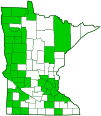Bruner’s spotted Joe pye weed
(Eutrochium maculatum var. bruneri)
Conservation • Wetland • Description • Habitat • Ecology • Use • Distribution • Taxonomy
Description |
||
Bruner’s spotted Joe pye weed is a 24″ to 80″ tall, erect, perennial forb that rises from a fibrous roots and sometimes rhizomes. The stems are erect and usually light green with purple spots but are sometimes more evenly purple. They are usually solid but are sometimes hollow near the base. They are usually not covered with a whitish, waxy coating (glaucous). They are densely covered from the base to the inflorescence with minute, short hairs. Most of the leaves are usually in whorls of 4 or 5, sometimes in whorls of 3 or 6. They do not have a tight bundle of small leaves in the leaf axils. They are on hairless, 1 ⁄16″ to 1″ long leaf stalks. The leaf blades are relatively thick, lance-shaped to elliptic or egg-shaped, 3″ to 10″ long, and 1″ to 3½″ wide. They are tapered to a sharp point at the tip and tapered gradually to the leaf stalk at the base. There is a single main vein. The upper surface is green, dull, and hairless. The lower surface is paler green and densely hairy. The margins are toothed with sharp, forward-pointing teeth. The uppermost whorl of leaves, the whorl directly subtending the inflorescence, is not broader than the inflorescence. The leaf blades of this whorl are ⅝″ to 1″ long and 1 ⁄16″ to 3 ⁄16″ wide. The inflorescence is a branched, elongated, flat-topped or nearly flat-topped array of numerous flower heads at the top of the stem. Each flower head has 8 to 22, usually 10 to 16, pale purple to pink disk florets and no ray florets. The fruit is a ⅛″ to 3 ⁄16″ long achene with a fluffy tuft of hairs attached. |
||
Height |
||
24″ to 80″ |
||
Flower Color |
||
Pale purple to pink |
||
Similar Species |
||
Holzinger’s eupatorium (Eupatorium purpureum var. holzingeri) stems are mostly green, purple only at the leaf nodes, and are rarely hollow near the base. The leaf undersurface is densely hairy. The inflorescence is dome-shaped, not flat-topped. The flower heads have 4 to 7 disk florets per head. Spotted Joe Pye weed (Eutrochium maculatum var. foliosum) uppermost whorl of leaves is much larger, as broad or broader than the inflorescence. The leaf blades of this whorl are 3″ to 8″ long and ¾″ to 1½″ wide. It has been reported only in Cook County. Spotted Joe Pye weed (Eutrochium maculatum var. maculatum) stems are hairless except for a covering of minute, short hairs near the top. The leaves are relatively thin. The leaf undersurface is usually hairless. Sweet Joe Pye weed (Eupatorium purpureum var. purpureum) stems are mostly green, purple only at the leaf nodes, and are rarely hollow near the base. The inflorescence is dome-shaped, not flat-topped. The flower heads have 4 to 7 disk florets per head. |
||
Habitat |
||
Wet to moist. Meadows, marshes, lakeshores. Full sun or partial shade. |
||
Ecology |
||
Flowering |
||
July to September |
||
Pests and Diseases |
||
|
||
Use |
||
|
||
Distribution |
||||
|
Sources |
|||
| 6/21/2023 | ||||
Nativity |
||||
Native |
||||
Occurrence |
||||
|
||||
Taxonomy |
|||
| Kingdom | Plantae (green algae and land plants) | ||
| Subkingdom | Viridiplantae (green plants) | ||
| Infrakingdom | Streptophyta (land plants and green algae) | ||
| Superdivision | Embryophyta (land plants) | ||
| Division | Tracheophyta (vascular plants) | ||
| Subdivision | Spermatophytina (seed plants) | ||
| Class | Magnoliopsida (flowering plants) | ||
| Superorder | Asteranae | ||
Order |
Asterales (sunflowers, bellflowers, fanflowers, and allies) | ||
Family |
Asteraceae (sunflowers, daisies, asters, and allies) | ||
| Subfamily | Asteroideae | ||
| Supertribe | Helianthodae | ||
| Tribe | Eupatorieae (bonesets, blazingstars, and allies) | ||
| Subtribe | Eupatoriinae | ||
| Genus | Eutrochium (Joe Pye weeds) | ||
| Species | Eutrochium maculatum (spotted Joe Pye weed) | ||
Joe Pye weeds were originally assigned to the genus Eupatorium. In 1836 a French botanist (Rafinesque) separated Joe Pye weeds from that genus and proposed assigning them to the genus Eutrochium. Unaware of Rafinesque’s work, in 1970 researchers at the Smithsonian Institution (King and Robinson) proposed the genus Eupatoriadelphus for Joe Pye weeds, and it was widely adopted. In 1987, further study by the same researchers convinced them to return Joe Pye weeds to Eupatorium. In 1999 and 2000, DNA studies at the University of Tennessee (Schilling) concluded yet again that Joe Pye weeds did not belong to Eupatorium, and they were returned to the genus Eupatoriadelphus. In 2004, a contributor to the Flora of North America (Lamont), recognizing the precedence of earlier-established names, transfered the species to Eutrochium. |
|||
Subordinate Taxa |
|||
|
|||
Synonyms |
|||
Eupatoriadelphus maculatus var. bruneri Eupatorium bruneri Eupatorium maculatum ssp. bruneri Eupatorium maculatum var. bruneri |
|||
Common Names |
|||
Bruner’s spotted Joe pye weed |
|||
Glossary
Achene
A dry, one-chambered, single-seeded seed capsule, formed from a single carpel, with the seed attached to the membranous outer layer (wall) only by the seed stalk; the wall, formed entirely from the wall of the superior ovary, does not split open at maturity, but relies on decay or predation to release the contents.
Glaucous
Pale green or bluish gray due to a whitish, powdery or waxy film, as on a plum or a grape.
Node
The small swelling of the stem from which one or more leaves, branches, or buds originate.
Rhizome
A horizontal, usually underground stem. It serves as a reproductive structure, producing roots below and shoots above at the nodes.
Visitor Photos |
|||||
Share your photo of this plant. |
|||||
| This button not working for you? Simply email us at info@MinnesotaSeasons.com. Attach one or more photos and, if you like, a caption. |
|||||
|
|||||
MinnesotaSeasons.com Photos |
|||||
Plant |
|||||
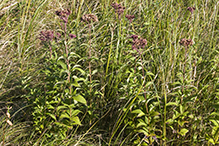 |
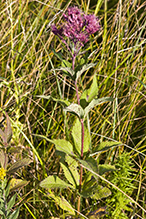 |
||||
Inflorescence |
|||||
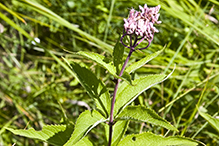 |
|||||
Leaves |
|||||
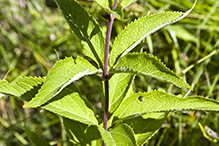 |
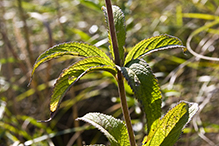 |
||||
Late Season |
|||||
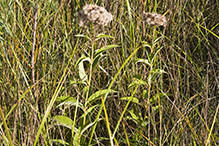 |
 |
||||

Slideshows |
||

Visitor Videos |
|||
Share your video of this plant. |
|||
| This button not working for you? Simply email us at info@MinnesotaSeasons.com. Attach a video, a YouTube link, or a cloud storage link. |
|||
Other Videos |
|||

Visitor Sightings |
|||||
Report a sighting of this plant. |
|||||
| This button not working for you? Simply email us at info@MinnesotaSeasons.com. Be sure to include a location. |
|||||
|
|||||
MinnesotaSeasons.com Sightings |
|||||

|
Created: Last Updated: © MinnesotaSeasons.com. All rights reserved. |
